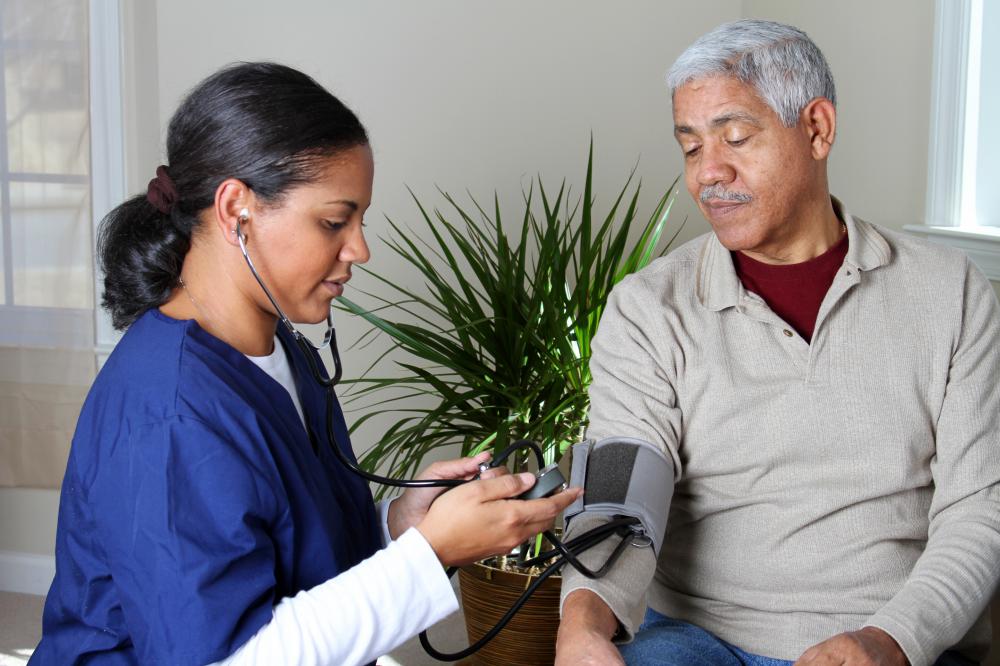At TheHealthBoard, we're committed to delivering accurate, trustworthy information. Our expert-authored content is rigorously fact-checked and sourced from credible authorities. Discover how we uphold the highest standards in providing you with reliable knowledge.
What is a Stethoscope?
A stethoscope is a diagnostic instrument used by medical professionals to listen to a patient's chest cavity, heart and various pulse points. Doctors use these tools as part of a non-invasive examination procedure, commonly listening for sounds of congestion in the lungs and irregular heartbeats. Nurses may also use them to listen for restored blood flow during blood pressure checks, among other procedures.
For centuries, physicians would literally place their ears directly on a patient's chest or back as part of an examination, a procedure medically called immediate auscultation. It was not unusual for these healthcare professionals to contract communicable diseases through such intimate contact with sick patients. In the early 19th century, a young French physician named Rene Theophile Hyacinthe Laennec found examining female patients this way to be a little discomforting. In 1816, Dr. Laennec fashioned a cylinder from several sheets of paper and used it to examine a young female patient. He discovered that internal sounds could be isolated and amplified through a tube, making examinations less intrusive and easier to interpret.

Dr. Laennec perfected his listening device using wooden tubes turned on a lathe. He wrote an important medical treatise on the new examination method, called mediate auscultation, in 1819. Colleagues convinced him to name his invention the stethoscope, after the Greek words for "chest" (stethos) and "to view" (scope). Laennec himself would die from tuberculosis in 1826.

Modern stethoscopes consist of a bell-shaped device with a clear plastic diaphragm, a length of rubber tubing, and a hollow metal headset with dual plastic earpieces. The disk-shaped diaphragm is placed directly on a patient's chest or back. As the patient takes deep breaths, sounds from the chest cavity are amplified through the diaphragm and bell. These sounds travel through the hollow rubber tube and headset, reaching the examiner's ears through tight-fitting earpieces. Any abnormal sounds, such as fluid retention or constriction of the airways, can be easily detected by trained medical professionals.

Heartbeats may also be heard through this device, although the diaphragm for a heart exam may be different from the ones used for respiratory exams. Different adjustments can filter out unwanted sounds in order to concentrate on a specific concern. Healthcare professionals may use a heart monitor to get an electronic reading of a patient's heart rate, but a stethoscope can reveal other abnormalities not easily measured by electronic equipment.
AS FEATURED ON:
AS FEATURED ON:















Discussion Comments
One crazy thing I did as a kid was to to insist to people I didn't have a heart. I was phobic about people touching my chest in case they felt one.
I convinced myself the vibrations I could feel, after running were produced by some non organic contraption inside me. In a routine exam, at age 11, I told the doctor I had no heart.
While he listened to my lungs, through my back, I got very nervous. What if he was to hear something more than my breath sounds? When he had me turn around and placed his stethoscope close to my left nipple I remember a surge of adrenaline gripped me. He listened intently for a moment, then gave me the stethoscope. The moment the diaphragm touched my chest I could hear a clear, fleshy thumping sound, very rapid and clear. That was the end of it; the myth was debunked.
Being very involved in athletics then, I often noticed the vibrations inside me. Knowing that I did have a heart after all didn't bother me for long. Indeed, I remember taking comfort in the fact.
@orangey03 – It amazes me how sensitive a stethoscope is to sound, too. Just by listening to my chest through it, my doctor can tell whether my congestion is in my chest or in my nose.
I came into her office with a terrible cough that was producing phlegm. I have had congestion like this coming just from my sinuses before, but this time, I suspected it was in my chest.
After a quick listen through the stethoscope, the doctor told me that she heard wheezing and whistling in my bronchial tubes. She gave me a shot of steroids and a dose pack to help give my body the strength to heal.
Had the cough been caused by my head sinuses only, she would have given me a decongestant and an antihistamine. However, since it was in my chest, she knew that this sort of medicine would not help whatsoever.
I understand how those women centuries ago felt strange when a doctor pressed his head up against their chests. That is a major violation of personal space!
I'm glad that the stethoscope was invented. Dr. Laennec was very considerate to try to discover a way to make them feel more comfortable. He probably didn't like being accused of inappropriate touching, either!
I like the fact that I don't have to disrobe in order for a doctor to use a stethoscope on me. He simple puts it under my shirt through the neck hole in the front and up my shirt from the hem in the back, and I don't feel strange about that at all.
Those stethoscope eartips are so little that it is astonishing how much a doctor can hear through them. I used to use some earphones about that size, and I could never get as good a sound out of them as I could with large headphones.
I have seen cartoons before featuring a character who is a patient grabbing the stethoscope and screaming into it while the eartips were in the doctor's ears. He jumped back and pulled them out of his ears, obviously in pain. I wonder if it would really hurt a doctor if someone yelled into his stethoscope.
I'm guessing that it would. If it can pick up on the sound of something as faint as a wheeze, then surely a loud sound would blast the eardrums.
I got sick a lot as a child, and I remember how cold the stethoscope felt against my skin. I would always jump back a little when the doctor placed it on me, because the sudden chill was so shocking.
It was especially cold against my back. I generally had a fever when I went in to see the doctor, and the skin of my back seemed to be super hot.
I think if the stethoscope had been just a little less cold, it might have felt good against my feverish back. I wanted to suggest that he keep it wrapped in a cloth, but I didn't have the courage.
this web site is so awesome. i had to do a research project and i got most of my info from here. this is a website that i would highly recommend for people to use if they need to get information.
when was the first stethoscope discovered?
Post your comments